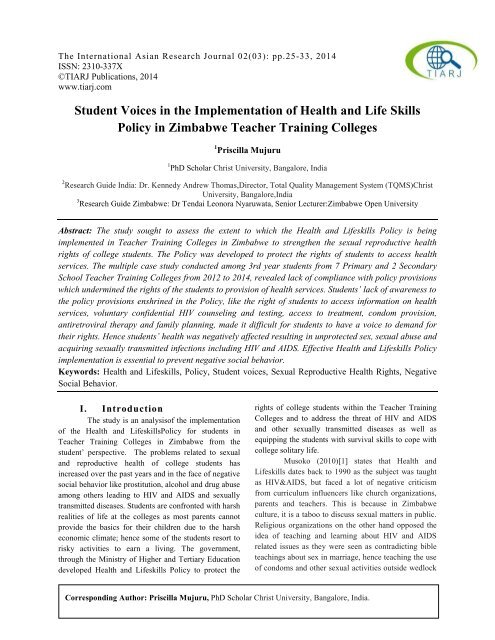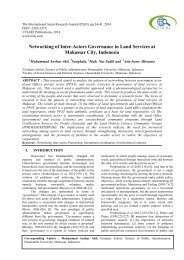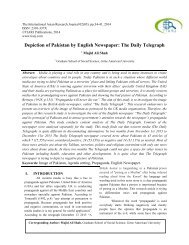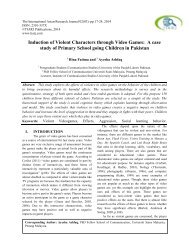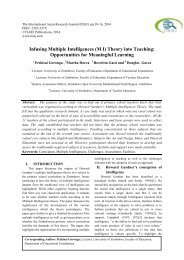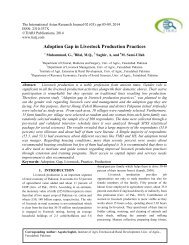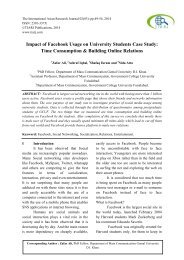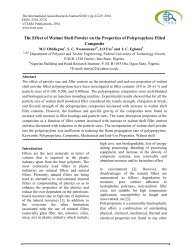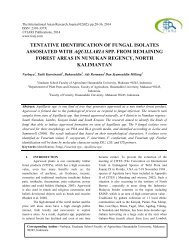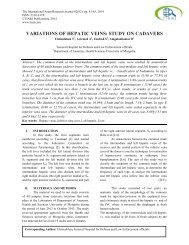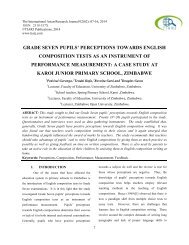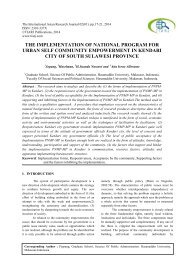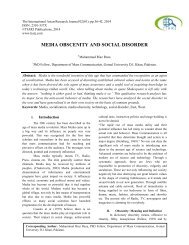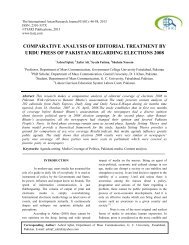Student Voices in the Implementation of Health and Lifeskills Policy in Zimbabwe Teacher Training Colleges. By: Priscilla Mujuru
You also want an ePaper? Increase the reach of your titles
YUMPU automatically turns print PDFs into web optimized ePapers that Google loves.
The International Asian Research Journal 02(03): pp.25-33, 2014<br />
ISSN: 2310-337X<br />
©TIARJ Publications, 2014<br />
www.tiarj.com<br />
<strong>Student</strong> <strong>Voices</strong> <strong>in</strong> <strong>the</strong> <strong>Implementation</strong> <strong>of</strong> <strong>Health</strong> <strong>and</strong> Life Skills<br />
<strong>Policy</strong> <strong>in</strong> <strong>Zimbabwe</strong> <strong>Teacher</strong> Tra<strong>in</strong><strong>in</strong>g <strong>Colleges</strong><br />
1 <strong>Priscilla</strong> <strong>Mujuru</strong><br />
1 PhD Scholar Christ University, Bangalore, India<br />
2 Research Guide India: Dr. Kennedy Andrew Thomas,Director, Total Quality Management System (TQMS)Christ<br />
University, Bangalore,India<br />
3 Research Guide <strong>Zimbabwe</strong>: Dr Tendai Leonora Nyaruwata, Senior Lecturer:<strong>Zimbabwe</strong> Open University<br />
Abstract: The study sought to assess <strong>the</strong> extent to which <strong>the</strong> <strong>Health</strong> <strong>and</strong> <strong>Lifeskills</strong> <strong>Policy</strong> is be<strong>in</strong>g<br />
implemented <strong>in</strong> <strong>Teacher</strong> Tra<strong>in</strong><strong>in</strong>g <strong>Colleges</strong> <strong>in</strong> <strong>Zimbabwe</strong> to streng<strong>the</strong>n <strong>the</strong> sexual reproductive health<br />
rights <strong>of</strong> college students. The <strong>Policy</strong> was developed to protect <strong>the</strong> rights <strong>of</strong> students to access health<br />
services. The multiple case study conducted among 3rd year students from 7 Primary <strong>and</strong> 2 Secondary<br />
School <strong>Teacher</strong> Tra<strong>in</strong><strong>in</strong>g <strong>Colleges</strong> from 2012 to 2014, revealed lack <strong>of</strong> compliance with policy provisions<br />
which underm<strong>in</strong>ed <strong>the</strong> rights <strong>of</strong> <strong>the</strong> students to provision <strong>of</strong> health services. <strong>Student</strong>s’ lack <strong>of</strong> awareness to<br />
<strong>the</strong> policy provisions enshr<strong>in</strong>ed <strong>in</strong> <strong>the</strong> <strong>Policy</strong>, like <strong>the</strong> right <strong>of</strong> students to access <strong>in</strong>formation on health<br />
services, voluntary confidential HIV counsel<strong>in</strong>g <strong>and</strong> test<strong>in</strong>g, access to treatment, condom provision,<br />
antiretroviral <strong>the</strong>rapy <strong>and</strong> family plann<strong>in</strong>g, made it difficult for students to have a voice to dem<strong>and</strong> for<br />
<strong>the</strong>ir rights. Hence students’ health was negatively affected result<strong>in</strong>g <strong>in</strong> unprotected sex, sexual abuse <strong>and</strong><br />
acquir<strong>in</strong>g sexually transmitted <strong>in</strong>fections <strong>in</strong>clud<strong>in</strong>g HIV <strong>and</strong> AIDS. Effective <strong>Health</strong> <strong>and</strong> <strong>Lifeskills</strong> <strong>Policy</strong><br />
implementation is essential to prevent negative social behavior.<br />
Keywords: <strong>Health</strong> <strong>and</strong> <strong>Lifeskills</strong>, <strong>Policy</strong>, <strong>Student</strong> voices, Sexual Reproductive <strong>Health</strong> Rights, Negative<br />
Social Behavior.<br />
I. Introduction<br />
The study is an analysis<strong>of</strong> <strong>the</strong> implementation<br />
<strong>of</strong> <strong>the</strong> <strong>Health</strong> <strong>and</strong> <strong>Lifeskills</strong><strong>Policy</strong> for students <strong>in</strong><br />
<strong>Teacher</strong> Tra<strong>in</strong><strong>in</strong>g <strong>Colleges</strong> <strong>in</strong> <strong>Zimbabwe</strong> from <strong>the</strong><br />
student’ perspective. The problems related to sexual<br />
<strong>and</strong> reproductive health <strong>of</strong> college students has<br />
<strong>in</strong>creased over <strong>the</strong> past years <strong>and</strong> <strong>in</strong> <strong>the</strong> face <strong>of</strong> negative<br />
social behavior like prostitution, alcohol <strong>and</strong> drug abuse<br />
among o<strong>the</strong>rs lead<strong>in</strong>g to HIV <strong>and</strong> AIDS <strong>and</strong> sexually<br />
transmitted diseases. <strong>Student</strong>s are confronted with harsh<br />
realities <strong>of</strong> life at <strong>the</strong> colleges as most parents cannot<br />
provide <strong>the</strong> basics for <strong>the</strong>ir children due to <strong>the</strong> harsh<br />
economic climate; hence some <strong>of</strong> <strong>the</strong> students resort to<br />
risky activities to earn a liv<strong>in</strong>g. The government,<br />
through <strong>the</strong> M<strong>in</strong>istry <strong>of</strong> Higher <strong>and</strong> Tertiary Education<br />
developed <strong>Health</strong> <strong>and</strong> <strong>Lifeskills</strong> <strong>Policy</strong> to protect <strong>the</strong><br />
rights <strong>of</strong> college students with<strong>in</strong> <strong>the</strong> <strong>Teacher</strong> Tra<strong>in</strong><strong>in</strong>g<br />
<strong>Colleges</strong> <strong>and</strong> to address <strong>the</strong> threat <strong>of</strong> HIV <strong>and</strong> AIDS<br />
<strong>and</strong> o<strong>the</strong>r sexually transmitted diseases as well as<br />
equipp<strong>in</strong>g <strong>the</strong> students with survival skills to cope with<br />
college solitary life.<br />
Musoko (2010)[1] states that <strong>Health</strong> <strong>and</strong><br />
<strong>Lifeskills</strong> dates back to 1990 as <strong>the</strong> subject was taught<br />
as HIV&AIDS, but faced a lot <strong>of</strong> negative criticism<br />
from curriculum <strong>in</strong>fluencers like church organizations,<br />
parents <strong>and</strong> teachers. This is because <strong>in</strong> <strong>Zimbabwe</strong><br />
culture, it is a taboo to discuss sexual matters <strong>in</strong> public.<br />
Religious organizations on <strong>the</strong> o<strong>the</strong>r h<strong>and</strong> opposed <strong>the</strong><br />
idea <strong>of</strong> teach<strong>in</strong>g <strong>and</strong> learn<strong>in</strong>g about HIV <strong>and</strong> AIDS<br />
related issues as <strong>the</strong>y were seen as contradict<strong>in</strong>g bible<br />
teach<strong>in</strong>gs about sex <strong>in</strong> marriage, hence teach<strong>in</strong>g <strong>the</strong> use<br />
<strong>of</strong> condoms <strong>and</strong> o<strong>the</strong>r sexual activities outside wedlock<br />
Correspond<strong>in</strong>g Author: <strong>Priscilla</strong> <strong>Mujuru</strong>, PhD Scholar 25 Christ University, Bangalore, India.
The International Asian Research Journal 02(03): pp.25-33, 2014<br />
was found to be immoral practice which was totally<br />
unacceptable. <strong>Teacher</strong>s as curriculum implementers<br />
regarded teach<strong>in</strong>g <strong>of</strong> HIV <strong>and</strong> AIDS alone as not<br />
enough for behavioural change towards reduc<strong>in</strong>g <strong>the</strong><br />
spread <strong>of</strong> HIV <strong>in</strong> <strong>the</strong> <strong>Zimbabwe</strong>an Society. Therefore<br />
<strong>the</strong> curriculum designers complied with <strong>the</strong> needs <strong>and</strong><br />
expectations <strong>of</strong> <strong>the</strong> society to widen <strong>and</strong> change <strong>the</strong><br />
subject to <strong>Health</strong> <strong>and</strong> <strong>Lifeskills</strong>. Rousseau(1712 –<br />
1778), <strong>the</strong> pioneer <strong>of</strong> child education, advocates that<br />
children must learn from <strong>the</strong>ir immediate environment<br />
<strong>and</strong> should be aware <strong>of</strong> all community issues <strong>and</strong> learn<br />
how to solve community challenges through embark<strong>in</strong>g<br />
on community projects. This led to <strong>the</strong> birth <strong>of</strong> <strong>Health</strong><br />
<strong>and</strong> <strong>Lifeskills</strong>.<br />
The study analyzed <strong>the</strong> effectiveness <strong>of</strong> <strong>the</strong><br />
implementation <strong>of</strong> <strong>the</strong> <strong>Health</strong> <strong>and</strong> <strong>Lifeskills</strong> policy <strong>in</strong><br />
colleges <strong>in</strong> relation to students’ sexual <strong>and</strong> reproductive<br />
health, more than 6 years after it was developed.<br />
Accord<strong>in</strong>g to <strong>the</strong> <strong>Zimbabwe</strong> Demographic <strong>and</strong> <strong>Health</strong><br />
Survey (2010 – 2011) [2], <strong>the</strong> age at first sexual<br />
<strong>in</strong>tercourse can be used as a proxy to <strong>the</strong> beg<strong>in</strong>n<strong>in</strong>g <strong>of</strong><br />
exposure to <strong>the</strong> risk <strong>of</strong> pregnancy. The median age at<br />
first sexual <strong>in</strong>tercourse for women aged 25 – 49 is 18.9<br />
years while for men <strong>of</strong> <strong>the</strong> same age group is 20.6<br />
years. <strong>By</strong> age <strong>of</strong> 20, about six <strong>in</strong> ten <strong>Zimbabwe</strong>an<br />
women have had sexual <strong>in</strong>tercourse while men exhibit a<br />
slightly older median age <strong>of</strong> 20.6years. This age range<br />
is <strong>the</strong> age group <strong>in</strong> which <strong>the</strong> college students fall <strong>in</strong>to.<br />
Sexuality education activities are guided by <strong>the</strong> Sexual<br />
Reproductive <strong>Health</strong> (2010 - 2015)[3] which <strong>of</strong>fers<br />
three approaches to address<strong>in</strong>g SRH issues <strong>of</strong> young<br />
people – health facility based approach; school based<br />
approach <strong>and</strong> community based approach. In<br />
<strong>Zimbabwe</strong>an schools, health <strong>and</strong> <strong>Lifeskills</strong> education is<br />
compulsory <strong>in</strong> all primary <strong>and</strong> secondary schools <strong>and</strong><br />
tertiary <strong>in</strong>stitutions, <strong>and</strong> HIV <strong>and</strong> AIDS is <strong>in</strong>tegrated<br />
<strong>in</strong>to relevant subjects. The research questions guid<strong>in</strong>g<br />
this study focused on <strong>the</strong> extent to which <strong>the</strong> <strong>Health</strong> <strong>and</strong><br />
<strong>Lifeskills</strong> policy is be<strong>in</strong>g implemented <strong>in</strong> <strong>Teacher</strong><br />
Tra<strong>in</strong><strong>in</strong>g <strong>Colleges</strong>; what HIV/AIDS services are be<strong>in</strong>g<br />
provided to pre-service teachers; <strong>the</strong> constra<strong>in</strong>ts faced<br />
by <strong>the</strong> teacher tra<strong>in</strong><strong>in</strong>g <strong>in</strong>stitutions to implement <strong>the</strong><br />
<strong>Health</strong> <strong>and</strong> <strong>Lifeskills</strong> <strong>Policy</strong> <strong>and</strong> how <strong>the</strong>se can be<br />
overcome to streng<strong>the</strong>n teacher tra<strong>in</strong><strong>in</strong>g <strong>and</strong> better<br />
prepare teachers to deliver effective <strong>Health</strong> <strong>and</strong><br />
<strong>Lifeskills</strong> education.<br />
1. Methodology:<br />
The multiple case study design was used for<br />
this study between 2012 <strong>and</strong> 2014. The study<br />
population was composed <strong>of</strong> 3 rd year exit students from<br />
7 <strong>Teacher</strong> Tra<strong>in</strong><strong>in</strong>g <strong>Colleges</strong> which prepare students for<br />
teach<strong>in</strong>g <strong>in</strong> both primary <strong>and</strong> secondary schools. The<br />
college <strong>in</strong>takes were different based on <strong>the</strong> size <strong>of</strong> <strong>the</strong><br />
college, hence <strong>the</strong> samples <strong>of</strong> <strong>the</strong> students were also<br />
proportional to <strong>the</strong> size <strong>of</strong> <strong>the</strong> <strong>in</strong>take.<br />
This group was selected realiz<strong>in</strong>g that <strong>the</strong>y are at <strong>the</strong><br />
po<strong>in</strong>t <strong>of</strong> exit<strong>in</strong>g <strong>the</strong> colleges after exposure to all <strong>the</strong><br />
education on health <strong>and</strong> <strong>Lifeskills</strong>. The student sample<br />
was selected us<strong>in</strong>g <strong>the</strong> convenient sampl<strong>in</strong>g method.<br />
Questionnaires were distributed to a total <strong>of</strong> 900<br />
students <strong>and</strong> 16 focus group discussions were done (two<br />
per college - one with a group <strong>of</strong> women <strong>and</strong> <strong>the</strong> o<strong>the</strong>r<br />
with a group <strong>of</strong> men). This enabled <strong>the</strong> students to be as<br />
open as possible without <strong>the</strong> element <strong>of</strong> shame or fear<br />
<strong>of</strong> ridicule. The f<strong>in</strong>d<strong>in</strong>gs <strong>in</strong> this article <strong>in</strong>clude issues<br />
that were raised through <strong>the</strong> focus group discussions<br />
<strong>and</strong> <strong>the</strong> questionnaires.<br />
II. THEORETICAL FRAMEWORK<br />
The study was based on <strong>the</strong> constructivist<br />
<strong>the</strong>oretical framework which focuses on <strong>the</strong> shift from<br />
<strong>the</strong> teacher to <strong>the</strong> students. The concept <strong>of</strong><br />
constructivism has roots <strong>in</strong> classical antiquity, go<strong>in</strong>g<br />
back to Socrates's dialogues with his followers, <strong>in</strong><br />
which he asked directed questions that led his students<br />
to realize for <strong>the</strong>mselves <strong>the</strong> weaknesses <strong>in</strong> <strong>the</strong>ir<br />
th<strong>in</strong>k<strong>in</strong>g. The Socratic dialogue is still an important tool<br />
<strong>in</strong> <strong>the</strong> way constructivist educators assess <strong>the</strong>ir students'<br />
learn<strong>in</strong>g <strong>and</strong> plan new learn<strong>in</strong>g experiences.<br />
In <strong>the</strong> constructivist model, <strong>the</strong> students are urged to be<br />
actively <strong>in</strong>volved <strong>in</strong> <strong>the</strong>ir own process <strong>of</strong> learn<strong>in</strong>g. The<br />
teacher functions more as a facilitator who coaches,<br />
mediates, prompts, <strong>and</strong> helps students develop <strong>and</strong><br />
assess <strong>the</strong>ir underst<strong>and</strong><strong>in</strong>g, <strong>and</strong> <strong>the</strong>reby <strong>the</strong>ir learn<strong>in</strong>g.<br />
One <strong>of</strong> <strong>the</strong> teacher's biggest jobs becomes ask<strong>in</strong>g good<br />
questions. Both teacher <strong>and</strong> students th<strong>in</strong>k <strong>of</strong><br />
knowledge not as <strong>in</strong>ert factoids to be memorized, but as<br />
a dynamic, ever-chang<strong>in</strong>g view <strong>of</strong> <strong>the</strong> world we live <strong>in</strong><br />
<strong>and</strong> <strong>the</strong> ability to successfully stretch <strong>and</strong> explore that<br />
view. Curriculum emphasizes big concepts, beg<strong>in</strong>n<strong>in</strong>g<br />
with <strong>the</strong> whole <strong>and</strong> exp<strong>and</strong><strong>in</strong>g to <strong>in</strong>clude <strong>the</strong><br />
parts.Pursuit <strong>of</strong> student questions <strong>and</strong> <strong>in</strong>terests is<br />
valued. Materials <strong>in</strong>clude primary sources <strong>of</strong> material<br />
<strong>and</strong> manipulative materials. <strong>Teacher</strong>'s role is<br />
<strong>in</strong>teractive, rooted <strong>in</strong> negotiation. Assessment <strong>in</strong>cludes<br />
student works, observations, <strong>and</strong> po<strong>in</strong>ts <strong>of</strong> view, as well<br />
as tests. Process is as important as product. Knowledge<br />
is seen as dynamic, ever chang<strong>in</strong>g with our experiences.<br />
26
The International Asian Research Journal 02(03): pp.25-33, 2014<br />
<strong>Student</strong>s work primarily <strong>in</strong> groups. Constructivist<br />
teachers pose questions <strong>and</strong> problems, <strong>the</strong>n guide<br />
students to help <strong>the</strong>m f<strong>in</strong>d <strong>the</strong>ir own answers. They use<br />
many techniques <strong>in</strong> <strong>the</strong> teach<strong>in</strong>g process. For example,<br />
<strong>the</strong>y may:<br />
prompt students to formulate <strong>the</strong>ir own<br />
questions (<strong>in</strong>quiry)<br />
allow multiple <strong>in</strong>terpretations <strong>and</strong> expressions<br />
<strong>of</strong> learn<strong>in</strong>g (multiple <strong>in</strong>telligences)<br />
encourage group work <strong>and</strong> <strong>the</strong> use <strong>of</strong> peers as<br />
resources (collaborative learn<strong>in</strong>g)<br />
It is important to realize that <strong>the</strong> constructivist<br />
approach borrows from many o<strong>the</strong>r practices <strong>in</strong> <strong>the</strong><br />
pursuit <strong>of</strong> its primary goal: help<strong>in</strong>g students learn how<br />
to learn. <strong>Student</strong>s are not blank slates upon which<br />
knowledge is etched. They come to learn<strong>in</strong>g situations<br />
with already formulated knowledge, ideas, <strong>and</strong><br />
underst<strong>and</strong><strong>in</strong>gs. This previous knowledge is <strong>the</strong> raw<br />
material for <strong>the</strong> new knowledge <strong>the</strong>y will create.The<br />
student is <strong>the</strong> person who creates new underst<strong>and</strong><strong>in</strong>g for<br />
him/herself. The teacher coaches, moderates, suggests,<br />
but allows <strong>the</strong> students room to experiment, ask<br />
questions, try th<strong>in</strong>gs that don't work. Learn<strong>in</strong>g activities<br />
require <strong>the</strong> students' full participation (like h<strong>and</strong>s -on<br />
experiments). An important part <strong>of</strong> <strong>the</strong> learn<strong>in</strong>g process<br />
is that students reflect on, <strong>and</strong> talk about, <strong>the</strong>ir<br />
activities.<br />
<strong>Student</strong>s also help set <strong>the</strong>ir own goals <strong>and</strong><br />
means <strong>of</strong> assessment. Examples: In <strong>Health</strong> <strong>and</strong><br />
<strong>Lifeskills</strong> education, ask<strong>in</strong>g students to read <strong>and</strong> th<strong>in</strong>k<br />
about different versions <strong>of</strong> <strong>and</strong> perspectives on HIV <strong>and</strong><br />
AIDS can lead to <strong>in</strong>terest<strong>in</strong>g discussions. Is HIV <strong>and</strong><br />
AIDS as taught <strong>in</strong> textbooks accurate? Are <strong>the</strong>re<br />
different versions <strong>of</strong> <strong>the</strong> same problem? Whose version<br />
<strong>of</strong> <strong>the</strong> orig<strong>in</strong> <strong>of</strong> HIV is most accurate? How do we<br />
know? From <strong>the</strong>re, students can make <strong>the</strong>ir own<br />
judgments, control <strong>the</strong>ir own learn<strong>in</strong>g process, <strong>and</strong> lead<br />
<strong>the</strong> way by reflect<strong>in</strong>g on <strong>the</strong>ir experiences. This process<br />
makes <strong>the</strong>m experts <strong>of</strong> <strong>the</strong>ir own learn<strong>in</strong>g. The teacher<br />
helps create situations where <strong>the</strong> students feel safe<br />
question<strong>in</strong>g <strong>and</strong> reflect<strong>in</strong>g on <strong>the</strong>ir own processes,<br />
ei<strong>the</strong>r privately or <strong>in</strong> group discussions. The teacher<br />
should also create activities that lead <strong>the</strong> student to<br />
reflect on his or her prior knowledge <strong>and</strong> experiences.<br />
Talk<strong>in</strong>g about what was learned <strong>and</strong> how it was learned<br />
is really important. College students will be expected to<br />
be creative when <strong>the</strong>y leave college to teach pupils <strong>in</strong><br />
<strong>the</strong> respective schools that <strong>the</strong>y will be expected to go<br />
to.<br />
Constructivism relies heavily on collaboration<br />
among students hence <strong>the</strong> importance <strong>of</strong> <strong>in</strong>volv<strong>in</strong>g <strong>the</strong>m<br />
<strong>in</strong> <strong>Health</strong> <strong>and</strong> <strong>Lifeskills</strong> <strong>Policy</strong> formulation <strong>and</strong> draft<strong>in</strong>g<br />
implementation strategies. There are many reasons why<br />
collaboration contributes to learn<strong>in</strong>g. The ma<strong>in</strong> reason it<br />
is that students learn about learn<strong>in</strong>g not only from<br />
<strong>the</strong>mselves, but also from <strong>the</strong>ir peers. When students<br />
review <strong>and</strong> reflect on <strong>the</strong>ir learn<strong>in</strong>g processes toge<strong>the</strong>r,<br />
<strong>the</strong>y can pick up strategies <strong>and</strong> methods from one<br />
ano<strong>the</strong>r, hence <strong>in</strong>troduction <strong>of</strong> peer education <strong>in</strong> <strong>Health</strong><br />
<strong>and</strong> <strong>Lifeskills</strong> education. The ma<strong>in</strong> activity <strong>in</strong> a<br />
constructivist classroom is solv<strong>in</strong>g problems. <strong>Student</strong>s<br />
use <strong>in</strong>quiry methods to ask questions, <strong>in</strong>vestigate a<br />
topic, <strong>and</strong> use a variety <strong>of</strong> resources to f<strong>in</strong>d solutions<br />
<strong>and</strong> answers. As students explore <strong>the</strong> topic, <strong>the</strong>y draw<br />
conclusions, <strong>and</strong>, as exploration cont<strong>in</strong>ues, <strong>the</strong>y revisit<br />
those conclusions. Exploration <strong>of</strong> questions leads to<br />
more questions. Constructivist teach<strong>in</strong>g takes <strong>in</strong>to<br />
account students' current conceptions <strong>and</strong> builds from<br />
<strong>the</strong>re. What happens when a student gets a new piece <strong>of</strong><br />
<strong>in</strong>formation? The constructivist model says that <strong>the</strong><br />
student compares <strong>the</strong> <strong>in</strong>formation to <strong>the</strong> knowledge <strong>and</strong><br />
underst<strong>and</strong><strong>in</strong>g he/she already has, <strong>and</strong> one <strong>of</strong> three<br />
th<strong>in</strong>gs can occur:<br />
The new <strong>in</strong>formation matches up with his previous<br />
knowledge pretty well (it's consonant with <strong>the</strong><br />
previous knowledge), so <strong>the</strong> student adds it to his<br />
underst<strong>and</strong><strong>in</strong>g. It may take some work, but it's just<br />
a matter <strong>of</strong> f<strong>in</strong>d<strong>in</strong>g <strong>the</strong> right fit, as with a puzzle<br />
piece.<br />
The <strong>in</strong>formation doesn't match previous knowledge<br />
(it's dissonant). The student has to change her<br />
previous underst<strong>and</strong><strong>in</strong>g to f<strong>in</strong>d a fit for <strong>the</strong><br />
<strong>in</strong>formation. This can be harder work.<br />
The <strong>in</strong>formation doesn't match previous<br />
knowledge, <strong>and</strong> it is ignored. Rejected bits <strong>of</strong><br />
<strong>in</strong>formation may just not be absorbed by <strong>the</strong><br />
student. Or <strong>the</strong>y may float around, wait<strong>in</strong>g for <strong>the</strong><br />
day when <strong>the</strong> student's underst<strong>and</strong><strong>in</strong>g has<br />
developed <strong>and</strong> permits a fit.<br />
1. What are <strong>the</strong> benefits <strong>of</strong> constructivism?<br />
Children learn more, <strong>and</strong> enjoy learn<strong>in</strong>g more<br />
when <strong>the</strong>y are actively <strong>in</strong>volved, ra<strong>the</strong>r than<br />
passive listeners.<br />
Education works best when it concentrates on<br />
th<strong>in</strong>k<strong>in</strong>g <strong>and</strong> underst<strong>and</strong><strong>in</strong>g, ra<strong>the</strong>r than on rote<br />
27
The International Asian Research Journal 02(03): pp.25-33, 2014<br />
memorization. Constructivism concentrates on<br />
learn<strong>in</strong>g how to th<strong>in</strong>k <strong>and</strong> underst<strong>and</strong>.<br />
Constructivist learn<strong>in</strong>g is transferable. In<br />
constructivist classrooms, students create<br />
organiz<strong>in</strong>g pr<strong>in</strong>ciples that <strong>the</strong>y can take with <strong>the</strong>m<br />
to o<strong>the</strong>r learn<strong>in</strong>g sett<strong>in</strong>gs.<br />
Constructivism gives students ownership <strong>of</strong> what<br />
<strong>the</strong>y learn, s<strong>in</strong>ce learn<strong>in</strong>g is based on students'<br />
questions <strong>and</strong> explorations, <strong>and</strong> <strong>of</strong>ten <strong>the</strong> students<br />
have a h<strong>and</strong> <strong>in</strong> design<strong>in</strong>g <strong>the</strong> assessments as well.<br />
Constructivist assessment engages <strong>the</strong> students'<br />
<strong>in</strong>itiatives <strong>and</strong> personal <strong>in</strong>vestments <strong>in</strong> <strong>the</strong>ir<br />
journals, research reports, physical models, <strong>and</strong><br />
artistic representations. Engag<strong>in</strong>g <strong>the</strong> creative<br />
<strong>in</strong>st<strong>in</strong>cts develops students' abilities to express<br />
knowledge through a variety <strong>of</strong> ways. The students<br />
are also more likely to reta<strong>in</strong> <strong>and</strong> transfer <strong>the</strong> new<br />
knowledge to real life.<br />
<strong>By</strong> ground<strong>in</strong>g learn<strong>in</strong>g activities <strong>in</strong> an au<strong>the</strong>ntic,<br />
real-world context, constructivism stimulates <strong>and</strong><br />
engages students. <strong>Student</strong>s <strong>in</strong> constructivist<br />
classrooms learn to question th<strong>in</strong>gs <strong>and</strong> to apply<br />
<strong>the</strong>ir natural curiosity to <strong>the</strong> world.<br />
Constructivism promotes social <strong>and</strong><br />
communication skills by creat<strong>in</strong>g a classroom<br />
environment that emphasizes collaboration <strong>and</strong><br />
exchange <strong>of</strong> ideas. <strong>Student</strong>s must learn how to<br />
articulate <strong>the</strong>ir ideas clearly as well as to<br />
collaborate on tasks effectively by shar<strong>in</strong>g <strong>in</strong> group<br />
projects. <strong>Student</strong>s must <strong>the</strong>refore exchange ideas<br />
<strong>and</strong> so must learn to "negotiate" with o<strong>the</strong>rs <strong>and</strong> to<br />
evaluate <strong>the</strong>ir contributions <strong>in</strong> a socially acceptable<br />
manner. This is essential to success <strong>in</strong> <strong>the</strong> real<br />
world, s<strong>in</strong>ce <strong>the</strong>y will always be exposed to a<br />
variety <strong>of</strong> experiences <strong>in</strong> which <strong>the</strong>y will have to<br />
cooperate <strong>and</strong> navigate among <strong>the</strong> ideas <strong>of</strong> o<strong>the</strong>rs.<br />
2. F<strong>in</strong>d<strong>in</strong>gs:<br />
<strong>Health</strong> <strong>and</strong> <strong>Lifeskills</strong> implementation utilizes<br />
<strong>the</strong> constructivist paradigm. F<strong>in</strong>d<strong>in</strong>gs presented <strong>in</strong> this<br />
study were based on <strong>the</strong> analysis <strong>of</strong> f<strong>in</strong>d<strong>in</strong>gs from data<br />
collected from students <strong>in</strong> <strong>the</strong> 7 <strong>Teacher</strong> Tra<strong>in</strong><strong>in</strong>g<br />
<strong>Colleges</strong> <strong>and</strong> <strong>the</strong> focus group discussions. The<br />
discussions focused on <strong>the</strong> voice <strong>of</strong> young people<br />
regard<strong>in</strong>g <strong>Health</strong> <strong>and</strong> <strong>Lifeskills</strong> <strong>in</strong>terventions which are<br />
<strong>of</strong>fered at <strong>Teacher</strong> Tra<strong>in</strong><strong>in</strong>g <strong>Colleges</strong>.<br />
Recommendations were made on <strong>the</strong> current status <strong>of</strong><br />
sexual <strong>and</strong> reproductive health issues affect<strong>in</strong>g college<br />
students. Implications for action <strong>and</strong> fur<strong>the</strong>r research<br />
were discussed.<br />
2.1 <strong>Health</strong> <strong>and</strong> <strong>Lifeskills</strong> <strong>Policy</strong> position:<br />
The f<strong>in</strong>d<strong>in</strong>gs showed that <strong>the</strong> Government<br />
through <strong>the</strong> M<strong>in</strong>istry <strong>of</strong> Higher <strong>and</strong> Tertiary Education<br />
developed an Education Sector Wide <strong>Health</strong> <strong>and</strong><br />
<strong>Lifeskills</strong> <strong>Policy</strong> to guide colleges <strong>in</strong> implement<strong>in</strong>g <strong>the</strong><br />
<strong>Health</strong> <strong>and</strong> <strong>Lifeskills</strong> <strong>Policy</strong> to protect <strong>the</strong> rights <strong>of</strong><br />
students’ sexual <strong>and</strong> reproductive health. O<strong>the</strong>r colleges<br />
also developed <strong>the</strong>ir own college specific <strong>Health</strong> <strong>and</strong><br />
<strong>Lifeskills</strong> Policies to respond to <strong>the</strong>ir college issues. In<br />
addition <strong>the</strong> Adolescent Reproductive <strong>Health</strong> Strategy<br />
(ASRH) 2010 – 2015 was developed to guide <strong>the</strong><br />
MOHCC’s efforts <strong>in</strong> provid<strong>in</strong>g quality, affordable <strong>and</strong><br />
appropriate sexual <strong>and</strong> reproductive health services to<br />
young people <strong>in</strong> <strong>Zimbabwe</strong>. <strong>Policy</strong> development is a<br />
positive step <strong>in</strong> ensur<strong>in</strong>g that <strong>the</strong>re is a framework <strong>of</strong><br />
implement<strong>in</strong>g activities. In this study, <strong>the</strong> <strong>Health</strong> <strong>and</strong><br />
<strong>Lifeskills</strong> was developed but not all students were<br />
aware <strong>of</strong> <strong>the</strong> existence <strong>of</strong> <strong>the</strong> policy which <strong>the</strong>n<br />
ultimately affects utilization <strong>in</strong> <strong>the</strong> policy provisions.<br />
Literature <strong>in</strong>dicates <strong>the</strong> importance <strong>of</strong> hav<strong>in</strong>g an HIV<br />
<strong>and</strong> AIDS policy (Dyk, 2004; Sarua, 2006) Responses<br />
on knowledge <strong>of</strong> students on existence <strong>of</strong> <strong>the</strong> policy<br />
<strong>in</strong>dicated that only 65% <strong>of</strong> <strong>the</strong> respondents were aware<br />
<strong>of</strong> <strong>the</strong> policy provisions. Of those students 45%<br />
confirmed lack <strong>of</strong> access to <strong>the</strong> policy documents s<strong>in</strong>ce<br />
<strong>the</strong>y were kept by <strong>the</strong> <strong>Health</strong> <strong>and</strong> <strong>Lifeskills</strong> Lecturers<br />
<strong>and</strong> not necessarily accessible to <strong>the</strong> students as <strong>and</strong><br />
when <strong>the</strong>y needed <strong>the</strong>m. The only time <strong>the</strong> students got<br />
to know about <strong>the</strong> policy was through brief<strong>in</strong>gs by <strong>the</strong><br />
<strong>Health</strong> <strong>and</strong> <strong>Lifeskills</strong> Lecturers dur<strong>in</strong>g orientation<br />
meet<strong>in</strong>gs <strong>and</strong> at workshops. . This f<strong>in</strong>d<strong>in</strong>g supports <strong>the</strong><br />
<strong>Zimbabwe</strong> Open University basel<strong>in</strong>e study (which<br />
found that students <strong>and</strong> Lecturers were not aware <strong>of</strong> <strong>the</strong><br />
HIV <strong>and</strong> AIDS policy with<strong>in</strong> <strong>the</strong> <strong>in</strong>stitution. The<br />
objectives <strong>of</strong> hav<strong>in</strong>g an HIV <strong>and</strong> AIDS policy <strong>in</strong><br />
<strong>in</strong>stitutions are given by literature as to reduce stigma<br />
<strong>and</strong> discrim<strong>in</strong>ation associated with HIV <strong>and</strong> AIDS,<br />
create supportive environment <strong>of</strong> compassion <strong>and</strong><br />
underst<strong>and</strong><strong>in</strong>g for students <strong>and</strong> Lecturer with HIV <strong>and</strong><br />
related illnesses; ensure that all students <strong>and</strong> staff<br />
members are treated equally whenever <strong>the</strong>y are <strong>in</strong>fected<br />
or not by HIV; provide all students <strong>and</strong> staff with <strong>the</strong><br />
<strong>in</strong>formation necessary to <strong>in</strong>crease <strong>the</strong>ir awareness <strong>of</strong> <strong>the</strong><br />
issues related to HIV <strong>in</strong>fections <strong>and</strong> AIDS; ensure that<br />
<strong>in</strong>stitutions or organizations provide prevention, care<br />
<strong>and</strong> support services to staff <strong>and</strong> students, to reduce<br />
personal, family <strong>and</strong> organizational impact <strong>of</strong> HIV <strong>and</strong><br />
AIDS <strong>and</strong> promote shared confidentiality among staff<br />
<strong>and</strong> students (University <strong>of</strong> Port Harcourt: 2007)<br />
28
The International Asian Research Journal 02(03): pp.25-33, 2014<br />
2.2 Status <strong>of</strong> <strong>Health</strong> <strong>and</strong> <strong>Lifeskills</strong> as a subject:<br />
The students confirmed that <strong>Health</strong> <strong>and</strong> <strong>Lifeskills</strong> was<br />
an exam<strong>in</strong>able subject <strong>in</strong> <strong>the</strong> syllabus (99.5%) <strong>and</strong><br />
failure <strong>in</strong> this subject required students to rewrite <strong>the</strong><br />
subject (92%). This fits <strong>in</strong> well with <strong>the</strong> constructivist<br />
<strong>the</strong>ory. The subject weight<strong>in</strong>g was not different from<br />
<strong>the</strong> o<strong>the</strong>r subjects. On adequacy <strong>of</strong> <strong>the</strong> time allotted to<br />
<strong>the</strong> subject, 56% <strong>of</strong> <strong>the</strong> students felt that <strong>the</strong> time was<br />
sufficient while 44% felt that <strong>the</strong> time was <strong>in</strong>adequate.<br />
2.3 Sources <strong>of</strong> Information:<br />
The students gave <strong>the</strong> follow<strong>in</strong>g as <strong>the</strong>ir ma<strong>in</strong> sources<br />
<strong>of</strong> <strong>in</strong>formation on <strong>Health</strong> <strong>and</strong> <strong>Lifeskills</strong> were:<br />
Sources <strong>of</strong> Percentage<br />
Information<br />
<strong>Health</strong> <strong>and</strong> 54%<br />
<strong>Lifeskills</strong> Lecturers<br />
Mass media 21.3%<br />
NGOs 10.4%<br />
Library 6.8%<br />
O<strong>the</strong>r 6.7%<br />
Despite <strong>the</strong> policy be<strong>in</strong>g <strong>in</strong> place <strong>the</strong> students stated that<br />
<strong>the</strong>y were not aware <strong>of</strong> <strong>the</strong> policy provisions for sexual<br />
reproductive health. This <strong>in</strong> turn made it difficult for <strong>the</strong><br />
students to dem<strong>and</strong> accountability to <strong>the</strong> service<br />
providers.<br />
2.4 Material resources<br />
The f<strong>in</strong>d<strong>in</strong>gs revealed that though <strong>the</strong> subject <strong>of</strong> <strong>Health</strong><br />
<strong>and</strong> <strong>Lifeskills</strong> was awarded <strong>the</strong> status <strong>of</strong> an exam<strong>in</strong>able<br />
subject, <strong>the</strong> colleges did not have adequate resources<br />
such as text books <strong>and</strong> reference books <strong>in</strong> comparison<br />
to o<strong>the</strong>r subjects. Absence <strong>of</strong> <strong>the</strong> textbooks as well as<br />
reference materials negates <strong>the</strong> importance <strong>and</strong><br />
weight<strong>in</strong>g attached to <strong>the</strong> subject.<br />
2.5 Competency <strong>of</strong> <strong>Health</strong> <strong>and</strong> <strong>Lifeskills</strong> Lecturers:<br />
<strong>Policy</strong> implementation with regard to competency <strong>of</strong><br />
lecturers, was positive based on comments received<br />
from students <strong>in</strong> colleges regard<strong>in</strong>g competence <strong>and</strong><br />
commitment <strong>of</strong> <strong>Lifeskills</strong> Lecturers <strong>and</strong> rated as good<br />
by 74% <strong>of</strong> <strong>the</strong> students. This was confirmed by <strong>the</strong><br />
f<strong>in</strong>d<strong>in</strong>gs from <strong>the</strong> focus group discussions which<br />
confirmed that <strong>the</strong> <strong>Health</strong> <strong>and</strong> <strong>Lifeskills</strong> were well<br />
<strong>in</strong>formed <strong>and</strong> capable <strong>of</strong> teach<strong>in</strong>g <strong>the</strong> subject. Some<br />
students however felt <strong>the</strong>y were not specialists <strong>and</strong><br />
<strong>of</strong>ten fell short <strong>of</strong> detailed health <strong>in</strong>formation which<br />
students required. <strong>Health</strong> <strong>and</strong> <strong>Lifeskills</strong> tra<strong>in</strong><strong>in</strong>g was<br />
seen as a niche <strong>of</strong> <strong>the</strong> <strong>Health</strong> <strong>and</strong> <strong>Lifeskills</strong> Lecturers<br />
only with<strong>in</strong> colleges as <strong>the</strong> o<strong>the</strong>r Lecturers <strong>in</strong>dicated<br />
lack <strong>of</strong> knowledge on what was <strong>in</strong>volved <strong>in</strong> <strong>Health</strong> <strong>and</strong><br />
<strong>Lifeskills</strong>. The attitude <strong>of</strong> “what is <strong>in</strong> it for me” was not<br />
supportive <strong>of</strong> effective policy implementation as some<br />
<strong>of</strong> <strong>the</strong> <strong>Health</strong> <strong>and</strong> <strong>Lifeskills</strong> Lecturers kept voic<strong>in</strong>g <strong>the</strong><br />
lack <strong>of</strong> <strong>in</strong>centives with donor withdrawal.<br />
2.6 Accessibility <strong>of</strong> <strong>Health</strong> Services:<br />
<strong>Health</strong> services were available but not always<br />
accessible for students eg. condom provision was<br />
discouraged <strong>in</strong> some colleges. In o<strong>the</strong>r colleges <strong>the</strong><br />
condoms were made available but <strong>in</strong>accessible for <strong>the</strong><br />
students because <strong>the</strong>y were kept <strong>in</strong> places that students<br />
would be unable to go <strong>and</strong> collect <strong>the</strong>m without be<strong>in</strong>g<br />
noticed. In church based colleges, students felt <strong>the</strong><br />
authorities considered <strong>the</strong> college a “holy place” where<br />
sexual relations were not practiced but <strong>in</strong> reality <strong>the</strong><br />
truth was that <strong>the</strong> students stated that <strong>the</strong>y would sneak<br />
<strong>in</strong>to <strong>the</strong> bushes outside school premises to have sexual<br />
relations. This resulted <strong>in</strong> students practic<strong>in</strong>g<br />
unprotected sex <strong>and</strong> <strong>the</strong> subsequent surge <strong>in</strong> sexually<br />
transmitted diseases as reported by <strong>the</strong> nurses at <strong>the</strong><br />
respective <strong>Teacher</strong> Tra<strong>in</strong><strong>in</strong>g <strong>Colleges</strong>.<br />
2.8 <strong>Health</strong> problems faced by college students:<br />
Table 2: Sexual <strong>and</strong> reproductive health problems that students face at college by age distribution<br />
Response by Age 20 -24 25 - 29 30 - 34 35 - 39 40 +<br />
STI 56.5 56.8 59.6 57.6 48.2<br />
HIV <strong>and</strong> AIDS 12.2 11.6 17.4 9.9 11.1<br />
29
The International Asian Research Journal 02(03): pp.25-33, 2014<br />
Unprotected Sex 2.7 3.8 1 4 11.1<br />
Sexual Harassment 25.5 25.8 21 27.2 29.6<br />
O<strong>the</strong>r 3.1 2 1 1.3 0<br />
Gr<strong>and</strong> Total 100 100 100 100 100<br />
Table 2 above shows <strong>the</strong> health problems<br />
faced by students <strong>in</strong> teacher Tra<strong>in</strong><strong>in</strong>g <strong>Colleges</strong>.<br />
Each student stated what <strong>the</strong>y considered <strong>the</strong> worst<br />
problem. Of major concern are <strong>the</strong> high numbers <strong>of</strong><br />
STIs <strong>and</strong> <strong>the</strong> issue <strong>of</strong> sexual harassment. Focus group<br />
discussions revealed that female students f<strong>in</strong>d<br />
<strong>the</strong>mselves <strong>in</strong> a difficult position because <strong>of</strong> Lecturers<br />
who make advances to <strong>the</strong>m for sexual favours. If <strong>the</strong>y<br />
deny <strong>the</strong>m <strong>the</strong> sexual favours <strong>the</strong>n <strong>the</strong>y compromise<br />
<strong>the</strong>ir success <strong>in</strong> studies. Church related <strong>in</strong>stitutions<br />
were not spared ei<strong>the</strong>r. Female students expressed<br />
frustration at hav<strong>in</strong>g cont<strong>in</strong>uous harassment from<br />
teachers, <strong>the</strong> church leadership <strong>and</strong> also male students<br />
all dem<strong>and</strong><strong>in</strong>g sexual favours from <strong>the</strong> same students.<br />
The most frustrat<strong>in</strong>g th<strong>in</strong>g was that <strong>the</strong>y could not<br />
report <strong>the</strong> violation <strong>of</strong> <strong>the</strong>ir rights for fear <strong>of</strong><br />
victimization <strong>and</strong> also as <strong>the</strong>re were no channels or<br />
forum for <strong>the</strong>m to report <strong>the</strong> harassment.<br />
Figure 1 Sexual <strong>and</strong> Reproductive <strong>Health</strong> problems<br />
/ Diseases that students face at college<br />
4%<br />
24%<br />
10%<br />
1%<br />
2.7 <strong>Health</strong> <strong>and</strong> <strong>Lifeskills</strong> service provision:<br />
On <strong>the</strong> provision <strong>of</strong> services, <strong>in</strong>adequate<br />
<strong>in</strong>formation on rights <strong>of</strong> students’ access to<br />
reproductive health services, like HIV <strong>and</strong> AIDS,<br />
voluntary test<strong>in</strong>g <strong>and</strong> counsel<strong>in</strong>g, access to drugs for<br />
STIs <strong>and</strong> ARVs, family plann<strong>in</strong>g services were raised<br />
as a concern by students. The study found out that<br />
<strong>the</strong>re were <strong>in</strong>adequate HIV <strong>and</strong> AIDS services, such as<br />
provision <strong>of</strong> Voluntary Counsell<strong>in</strong>g <strong>and</strong> Test<strong>in</strong>g<br />
(VCT) which was <strong>of</strong>ten outsourced <strong>in</strong> most<br />
<strong>in</strong>stitutions. Drugs for STIs <strong>and</strong> ARVs were<br />
61%<br />
STI<br />
HIV <strong>and</strong> AIDS<br />
Unprotected Sex<br />
Sexual Harrassment<br />
O<strong>the</strong>r<br />
<strong>in</strong>adequate result<strong>in</strong>g <strong>in</strong> high cases <strong>of</strong> STIs, HIV <strong>and</strong><br />
AIDS at <strong>the</strong> colleges. The family plann<strong>in</strong>g services<br />
<strong>of</strong>fered were <strong>in</strong>adequate or <strong>in</strong> some cases non-existent.<br />
2.9 Confidentiality:<br />
A major concern for <strong>the</strong> students was <strong>the</strong> lack<br />
<strong>of</strong> confidentiality <strong>in</strong> <strong>the</strong> counsell<strong>in</strong>g <strong>of</strong>fered by College<br />
Based <strong>Health</strong> Care Providers, to which <strong>the</strong> resultant<br />
underutilization <strong>of</strong> health services was attributed.<br />
<strong>Student</strong>s preferred visit<strong>in</strong>g Counsellors <strong>in</strong>stead.<br />
However students raised concern about <strong>the</strong> irregular<br />
services which <strong>the</strong> visit<strong>in</strong>g Counsellors provided.<br />
2.10 Areas need<strong>in</strong>g streng<strong>the</strong>n<strong>in</strong>g:<br />
On areas that needed streng<strong>the</strong>n<strong>in</strong>g, students<br />
po<strong>in</strong>ted out that for <strong>the</strong> majority <strong>of</strong> <strong>the</strong>m <strong>the</strong>re were no<br />
real strong role models at <strong>the</strong>ir colleges; <strong>the</strong>y<br />
highlighted <strong>the</strong> need for learn<strong>in</strong>g materials (34%);<br />
participatory teach<strong>in</strong>g methods (18.6%), improvement<br />
<strong>of</strong> attitudes by Lecturers <strong>and</strong> <strong>Health</strong> Service providers<br />
(18.3%) <strong>and</strong> provision <strong>of</strong> <strong>in</strong>formation on<br />
communicable diseases, provision <strong>of</strong> condoms <strong>and</strong><br />
provision <strong>of</strong> food. Referrals to established health<br />
facilities was a cost that most students could not<br />
afford.<br />
2.11 <strong>Student</strong> competency to teach <strong>the</strong> subject:<br />
Be<strong>in</strong>g third year exit students, <strong>the</strong>y would be deployed<br />
to schools <strong>and</strong> expected to impart <strong>the</strong> knowledge on<br />
<strong>Health</strong> <strong>and</strong> <strong>Lifeskills</strong> that <strong>the</strong>y learnt at <strong>the</strong> <strong>Colleges</strong>,<br />
so <strong>the</strong>y were asked to rate <strong>the</strong>mselves regard<strong>in</strong>g skills<br />
<strong>in</strong> teach<strong>in</strong>g students about <strong>Health</strong> <strong>and</strong> <strong>Lifeskills</strong>. The<br />
majority (51.9%) stated that <strong>the</strong>y had enough<br />
knowledge <strong>and</strong> experience to take up <strong>the</strong> task, while<br />
<strong>the</strong> o<strong>the</strong>rs still needed more knowledge, skills <strong>and</strong><br />
experience. All students get exposed to HIV <strong>and</strong> AIDS<br />
education dur<strong>in</strong>g teach<strong>in</strong>g practice. Approximately<br />
89.9% <strong>of</strong> <strong>the</strong> students confirmed that <strong>the</strong>y had <strong>the</strong><br />
opportunity to teach about HIV <strong>and</strong> AIDS, <strong>Health</strong> <strong>and</strong><br />
related <strong>Lifeskills</strong> activities dur<strong>in</strong>g workshops,<br />
guidance <strong>and</strong> counsel<strong>in</strong>g sessions <strong>and</strong> awareness<br />
campaigns.<br />
2.12 Monitor<strong>in</strong>g <strong>of</strong> students on teach<strong>in</strong>g practice:<br />
30
The International Asian Research Journal 02(03): pp.25-33, 2014<br />
<strong>Student</strong>s expressed concern with<strong>in</strong>adequate<br />
monitor<strong>in</strong>g <strong>and</strong> follow up <strong>of</strong> students on teach<strong>in</strong>g<br />
practice by <strong>Health</strong> <strong>and</strong> <strong>Lifeskills</strong> Lecturers due to lack<br />
<strong>of</strong> transport <strong>and</strong> shortage <strong>of</strong> staff. Some students on<br />
teach<strong>in</strong>g practice were not given <strong>the</strong> opportunity to<br />
teach health <strong>and</strong> life skills by <strong>the</strong>ir mentors <strong>in</strong> <strong>the</strong><br />
schools where <strong>the</strong>y did <strong>the</strong>ir teach<strong>in</strong>g practice, even<br />
though <strong>the</strong> subject had time allotted on <strong>the</strong> syllabus.<br />
2.13 NGO support to <strong>the</strong> colleges:<br />
NGO support to <strong>the</strong> colleges was m<strong>in</strong>imal or<br />
nonexistent <strong>in</strong> some colleges, as <strong>the</strong> NGOs had<br />
changed focus leav<strong>in</strong>g <strong>the</strong> programme without<br />
adequate f<strong>in</strong>ancial support <strong>and</strong> <strong>the</strong>refore marg<strong>in</strong>alized.<br />
Lack <strong>of</strong> resources <strong>in</strong> <strong>the</strong> colleges forced some students<br />
to engage <strong>in</strong> negative social behavior like prostitution<br />
to get money for basic needs.<br />
2.14 Forum for air<strong>in</strong>g concerns:<br />
<strong>Student</strong>s bemoaned <strong>the</strong> lack <strong>of</strong> a voice <strong>and</strong> opportunity<br />
to discuss <strong>the</strong>ir concerns with college authorities for<br />
fear <strong>of</strong> victimization, e.g. regard<strong>in</strong>g <strong>the</strong> private issue <strong>of</strong><br />
<strong>in</strong>teraction between boys <strong>and</strong> girls after school; this<br />
was not permitted especially <strong>in</strong> church related<br />
<strong>in</strong>stitutions. This led to students resort<strong>in</strong>g to<br />
unorthodox means <strong>of</strong> fulfill<strong>in</strong>g <strong>the</strong>ir sexual desires<br />
us<strong>in</strong>g unprotected means <strong>and</strong> <strong>the</strong> subsequent surge <strong>in</strong><br />
sexually transmitted diseases. A testimony was given<br />
by a married student whose husb<strong>and</strong> was also at <strong>the</strong><br />
same college that <strong>the</strong>y had no access <strong>of</strong> see<strong>in</strong>g each<br />
o<strong>the</strong>r until <strong>the</strong> school holidays because <strong>the</strong> college did<br />
not permit any such <strong>in</strong>teraction. The students felt <strong>the</strong>y<br />
lacked strong role models.<br />
2.15Negative behavioural factors:<br />
Negative behavioural factors by students<br />
were highlighted. These <strong>in</strong>cluded promiscuity by some<br />
students for favours such as to pass exam<strong>in</strong>ations. Peer<br />
pressure led new students, who felt isolated, <strong>in</strong>to<br />
smok<strong>in</strong>g, dr<strong>in</strong>k<strong>in</strong>g <strong>and</strong> tak<strong>in</strong>g drugs to have to have a<br />
sense <strong>of</strong> belong<strong>in</strong>g. Pressure by female students <strong>in</strong><br />
<strong>the</strong>ir last year <strong>of</strong> college, who were desperate to get<br />
married before <strong>the</strong>y leave college, led <strong>the</strong>m <strong>in</strong>to<br />
hav<strong>in</strong>g unprotected sex so that <strong>the</strong>y fall pregnant as a<br />
way <strong>of</strong> security to get <strong>the</strong> responsible man to marry<br />
<strong>the</strong>m. This led <strong>the</strong>m <strong>in</strong>to acquir<strong>in</strong>g STIs, HIV <strong>and</strong><br />
AIDS.<br />
IV. DISCUSSION<br />
Contrary to <strong>the</strong> constructivist perspective <strong>of</strong><br />
<strong>in</strong>volv<strong>in</strong>g learners to actively participate <strong>in</strong> <strong>the</strong><br />
learn<strong>in</strong>g situation, students reported non participation<br />
<strong>in</strong> policy formulation <strong>and</strong> implementation <strong>of</strong> <strong>the</strong> policy<br />
provisions. The critical importance <strong>of</strong> <strong>in</strong>volvement <strong>of</strong><br />
<strong>the</strong> young people <strong>in</strong> <strong>Teacher</strong> Tra<strong>in</strong><strong>in</strong>g <strong>Colleges</strong> <strong>in</strong><br />
<strong>Health</strong> <strong>and</strong> <strong>Lifeskills</strong> h<strong>in</strong>ges on <strong>the</strong> resultant two<br />
pronged benefit <strong>of</strong> atta<strong>in</strong><strong>in</strong>g life skills <strong>in</strong>formation for<br />
<strong>the</strong>ir personal benefit as well as for <strong>the</strong>ir subsequent<br />
clientele (pupils <strong>in</strong> Primary <strong>and</strong> Secondary Schools<br />
<strong>and</strong> <strong>the</strong> community at large). Therefore importance <strong>of</strong><br />
<strong>the</strong> preparation for this role cannot be overemphasized.<br />
It has to be comprehensive <strong>and</strong> <strong>of</strong> good quality<br />
ensur<strong>in</strong>g accuracy <strong>in</strong> <strong>the</strong> <strong>in</strong>formation imparted. Good<br />
<strong>and</strong> appropriate communication skills are vital to <strong>the</strong><br />
successful dissem<strong>in</strong>ation <strong>of</strong> <strong>the</strong> <strong>in</strong>formation to <strong>the</strong><br />
pupils.<br />
The competence level <strong>of</strong> <strong>the</strong> Life Skills<br />
Lecturers <strong>in</strong> manag<strong>in</strong>g <strong>the</strong> <strong>Health</strong> <strong>and</strong> Life skills<br />
programme <strong>in</strong> colleges is an important issue po<strong>in</strong>t<strong>in</strong>g<br />
to lack <strong>of</strong> awareness <strong>of</strong> <strong>the</strong> impact student <strong>in</strong>volvement<br />
on <strong>the</strong> operationalization <strong>of</strong> <strong>the</strong> <strong>Health</strong> <strong>and</strong> <strong>Lifeskills</strong><br />
policies <strong>and</strong> articulat<strong>in</strong>g <strong>the</strong> correct facts regard<strong>in</strong>g <strong>the</strong><br />
<strong>Health</strong> <strong>and</strong> <strong>Lifeskills</strong> programme. Congruency<br />
between <strong>the</strong> <strong>Health</strong> <strong>and</strong> Life Skills Lecturers <strong>and</strong><br />
students’ <strong>in</strong>terests should be managed <strong>in</strong> all contexts<br />
<strong>and</strong> this could <strong>in</strong>deed be <strong>the</strong> <strong>in</strong>itial phase <strong>in</strong> address<strong>in</strong>g<br />
<strong>Health</strong> <strong>and</strong> <strong>Lifeskills</strong> programme implementation<br />
challenges through student engagement to address <strong>the</strong><br />
students’ sexual reproductive health needs. <strong>Lifeskills</strong><br />
Lecturers who fail to share <strong>the</strong> same vision with<br />
students result <strong>in</strong> management discord which results <strong>in</strong><br />
<strong>the</strong> erosion <strong>of</strong> skills <strong>and</strong> talent through failure to <strong>in</strong>vest<br />
<strong>in</strong> students’ brilliant ideas for <strong>the</strong> benefit <strong>of</strong> <strong>the</strong><br />
programme <strong>and</strong> students. In situations where <strong>the</strong><br />
<strong>Health</strong> <strong>and</strong> <strong>Lifeskills</strong> Lecturers are passive, this<br />
charade can unfortunately cont<strong>in</strong>ue until <strong>the</strong> students<br />
exit <strong>the</strong> colleges, without benefit<strong>in</strong>g much on health<br />
<strong>and</strong> <strong>Lifeskills</strong> to go <strong>and</strong> impart <strong>the</strong> little <strong>the</strong>y learnt,<br />
which may not be quality content, to students at<br />
Primary <strong>and</strong> Secondary School levels. Because <strong>of</strong> lack<br />
<strong>of</strong> confidence <strong>in</strong> <strong>the</strong> subject area <strong>the</strong> same attitude is<br />
<strong>the</strong>n cascaded to lower levels, <strong>the</strong> school children. For<br />
some <strong>Health</strong> <strong>and</strong> <strong>Lifeskills</strong> Lecturers, <strong>the</strong> “what’s <strong>in</strong> it<br />
for me?” attitude is prevalent <strong>and</strong> <strong>the</strong>re is no evidence<br />
<strong>of</strong> <strong>in</strong>tentions to control this negative attitude towards<br />
performance. The risk is that, if not controlled <strong>the</strong><br />
contagion effect <strong>of</strong> this attitude will spread throughout<br />
<strong>the</strong> colleges at <strong>the</strong> students’ expense <strong>and</strong> to <strong>the</strong><br />
31
The International Asian Research Journal 02(03): pp.25-33, 2014<br />
detriment <strong>of</strong> <strong>the</strong> programme. This leaves <strong>Lifeskills</strong><br />
Lecturers with no option but to pursue student<br />
engagement strategies <strong>in</strong> order to achieve superior<br />
performance results <strong>in</strong> address<strong>in</strong>g students’<br />
reproductive health concerns with<strong>in</strong> <strong>the</strong> <strong>Health</strong> <strong>and</strong><br />
<strong>Lifeskills</strong> programme.<br />
V. Gaps identified<br />
The follow<strong>in</strong>g gaps were identified with<strong>in</strong><br />
teacher tra<strong>in</strong><strong>in</strong>g colleges on prepar<strong>in</strong>g students for<br />
dissem<strong>in</strong>ation <strong>of</strong> correct <strong>in</strong>formation on sexual<br />
reproductive health:<br />
V.4 Challeng<strong>in</strong>g policy environment – lack <strong>of</strong> access<br />
to policy guidel<strong>in</strong>es for students with<strong>in</strong> <strong>the</strong><br />
colleges <strong>and</strong> undocumented practices<br />
implemented as policy <strong>in</strong> some <strong>Teacher</strong> Tra<strong>in</strong><strong>in</strong>g<br />
<strong>Colleges</strong>.<br />
V.5 <strong>Implementation</strong> by some colleges <strong>of</strong> policies that<br />
contradict provision <strong>of</strong> some aspects <strong>of</strong><br />
reproductive health <strong>in</strong> TTC eg. lack <strong>of</strong> accessible<br />
condoms to students <strong>in</strong> colleges.<br />
V.6 Policies that that are bl<strong>in</strong>d to reproductive health<br />
needs <strong>of</strong> students eg. sexual harassment,<br />
expulsion <strong>of</strong> students who are pregnant regardless<br />
<strong>of</strong> <strong>the</strong>ir marital status <strong>and</strong> gender based violence<br />
with<strong>in</strong> <strong>the</strong> colleges.<br />
V.7 Peer <strong>in</strong>fluence - drug <strong>and</strong> alcohol abuse, poverty<br />
leads to sexual <strong>in</strong>tercourse for f<strong>in</strong>ancial benefit.<br />
<strong>Student</strong>s also engage <strong>in</strong> negative social<br />
behaviours to ga<strong>in</strong> small favours eg. to pass, to get<br />
job opportunities <strong>and</strong> for recognition.<br />
V.8 Inadequate <strong>in</strong>formation, education to equip<br />
students aga<strong>in</strong>st <strong>the</strong> negative social behavior <strong>and</strong><br />
attitudes on STI, HIV <strong>and</strong> AIDS<br />
VI.<br />
Recommendations:<br />
I.1 Role <strong>of</strong> <strong>the</strong> Government: With<strong>in</strong> <strong>the</strong> context <strong>of</strong><br />
voice <strong>and</strong> accountability, M<strong>in</strong>istry <strong>of</strong> Higher <strong>and</strong><br />
Tertiary Education <strong>and</strong> <strong>the</strong> <strong>Teacher</strong> Tra<strong>in</strong><strong>in</strong>g<br />
<strong>Colleges</strong> to streng<strong>the</strong>n operationalization,<br />
implementation <strong>and</strong> monitor<strong>in</strong>g <strong>of</strong> <strong>Health</strong> <strong>and</strong><br />
<strong>Lifeskills</strong> Policies to ensure adequate <strong>and</strong><br />
effective dissem<strong>in</strong>ation <strong>of</strong> <strong>the</strong> policy <strong>and</strong><br />
guidel<strong>in</strong>es among <strong>the</strong> college students. There is<br />
need for jo<strong>in</strong>t M<strong>in</strong>istry approach – M<strong>in</strong>istry <strong>of</strong><br />
<strong>Health</strong> <strong>and</strong> M<strong>in</strong>istry <strong>of</strong> Higher <strong>and</strong> Tertiary<br />
Education <strong>and</strong> M<strong>in</strong>istry <strong>of</strong> Primary <strong>and</strong> Secondary<br />
Education approach to address<strong>in</strong>g <strong>Health</strong> <strong>and</strong><br />
<strong>Lifeskills</strong> education issues affect<strong>in</strong>g students <strong>in</strong><br />
<strong>Teacher</strong> tra<strong>in</strong><strong>in</strong>g colleges as this <strong>in</strong> turn cascades<br />
to <strong>the</strong>ir pupils <strong>in</strong> primary <strong>and</strong> secondary schools.<br />
I.2 Voice for students:<br />
There is need for a platform <strong>and</strong> safe spaces<br />
to streng<strong>the</strong>n <strong>the</strong> voice students to express <strong>the</strong>ir<br />
views <strong>and</strong> grievances without fear <strong>of</strong><br />
victimization. This entails empowerment <strong>of</strong><br />
students to dem<strong>and</strong> for <strong>the</strong>ir sexual reproductive<br />
health rights <strong>and</strong> participat<strong>in</strong>g <strong>in</strong> positive<br />
<strong>in</strong>itiatives that develop personal, social skills,<br />
promote well-be<strong>in</strong>g <strong>and</strong> reduce risky social<br />
behavior. There is need for <strong>the</strong> removal <strong>of</strong> barriers<br />
<strong>and</strong> improv<strong>in</strong>g direct access <strong>of</strong> students <strong>in</strong> fora<br />
that engage students with college decision makers<br />
to deliberate on issues affect<strong>in</strong>g <strong>the</strong> rights <strong>of</strong><br />
students. <strong>Student</strong>s to be ultimately prepared for<br />
<strong>the</strong>ir future role as role models <strong>and</strong> advocates for<br />
behaviour change <strong>in</strong> <strong>the</strong> community.<br />
I.3 Responsibilities <strong>of</strong> College Authorities: College<br />
authorities to design <strong>and</strong> ensure availability <strong>of</strong> <strong>the</strong><br />
<strong>Health</strong> <strong>and</strong> <strong>Lifeskills</strong> <strong>Policy</strong> <strong>and</strong> tra<strong>in</strong><strong>in</strong>g<br />
programmes, equip <strong>the</strong> students with skills to<br />
adequately protect <strong>the</strong>mselves from diseases e.g.<br />
sexually transmitted <strong>in</strong>fections <strong>and</strong> not only<br />
outsourc<strong>in</strong>g this service to NGOs.<br />
I.4 Role <strong>of</strong> <strong>the</strong> community: The community groups<br />
<strong>and</strong> <strong>Health</strong> promotion networks to <strong>in</strong>corporate<br />
young people from Institutions <strong>of</strong> Higher learn<strong>in</strong>g<br />
<strong>in</strong> <strong>the</strong>ir communities to participate on <strong>the</strong>ir boards<br />
<strong>in</strong> a bid to streng<strong>the</strong>n <strong>the</strong> voice <strong>of</strong> students. The<br />
community can streng<strong>the</strong>n <strong>the</strong> voice <strong>of</strong> <strong>the</strong> youth<br />
<strong>and</strong> duty bearers to be accountable for <strong>the</strong> health<br />
<strong>of</strong> young people. Ensur<strong>in</strong>g provision <strong>and</strong><br />
availability <strong>of</strong> good health is everyone’s right <strong>and</strong><br />
responsibility.<br />
VII.<br />
Proposed areas for fur<strong>the</strong>r research<br />
I. How can students empowered to fight for<br />
<strong>the</strong>ir rights with<strong>in</strong> <strong>the</strong>ir respective colleges<br />
without compromis<strong>in</strong>g <strong>the</strong>ir studies? Rights<br />
<strong>of</strong> young people are claims or entitlements<br />
that accrue by virtue <strong>of</strong> <strong>the</strong> fact that <strong>the</strong>y are<br />
young people, <strong>the</strong>re are human rights that are<br />
universal <strong>and</strong> cannot be taken away from<br />
anyone eg, right to health, safe <strong>and</strong> satisfy<strong>in</strong>g<br />
32
The International Asian Research Journal 02(03): pp.25-33, 2014<br />
VIII.<br />
II.<br />
sex <strong>and</strong> <strong>the</strong> right to equal treatment <strong>and</strong> right<br />
to bodily <strong>in</strong>tegrity.<br />
What is <strong>the</strong> role <strong>of</strong> <strong>the</strong> community groups <strong>in</strong><br />
<strong>the</strong> prevention <strong>of</strong> negative social behaviours<br />
among students, without undue <strong>in</strong>terference<br />
to <strong>the</strong> smooth function<strong>in</strong>g <strong>of</strong> colleges, <strong>in</strong> view<br />
<strong>of</strong> <strong>the</strong> fact that colleges are autonomous.<br />
CONCLUSION:<br />
The study highlighted <strong>the</strong> gaps <strong>in</strong> <strong>the</strong><br />
implementation <strong>of</strong> <strong>Health</strong> <strong>and</strong> <strong>Lifeskills</strong> <strong>Policy</strong><br />
with<strong>in</strong> <strong>the</strong> <strong>Teacher</strong> Tra<strong>in</strong><strong>in</strong>g colleges.<br />
Dissem<strong>in</strong>ation <strong>of</strong> <strong>the</strong> <strong>Policy</strong> to students needs to<br />
be on a wider scale <strong>and</strong> operationalized to uphold<br />
<strong>the</strong> sexual <strong>and</strong> reproductive health rights <strong>of</strong><br />
students <strong>in</strong> teacher tra<strong>in</strong><strong>in</strong>g colleges <strong>and</strong> to spell<br />
out <strong>the</strong> responsibilities <strong>of</strong> College authorities so<br />
that students are aware <strong>of</strong> <strong>the</strong>m. <strong>Student</strong>s need<br />
smooth transition <strong>and</strong> protection by school<br />
authorities, from be<strong>in</strong>g cushioned <strong>in</strong> <strong>the</strong> comfort<br />
<strong>of</strong> home to <strong>the</strong> harsh realities <strong>of</strong> college life, by<br />
rais<strong>in</strong>g awareness <strong>of</strong> <strong>the</strong> negative <strong>in</strong>fluences that<br />
students are likely to meet <strong>and</strong> how to cope.<br />
<strong>Student</strong>s also need to be responsible for <strong>the</strong>ir own<br />
health, <strong>the</strong>ir fellow students <strong>and</strong> <strong>the</strong> community’s<br />
health. <strong>Colleges</strong> should provide safe places <strong>and</strong><br />
privacy for students to <strong>in</strong>teract. There is need for<br />
a platform <strong>and</strong> safe spaces for students to express<br />
<strong>the</strong>ir voices, views <strong>and</strong> grievances without fear <strong>of</strong><br />
victimization.<br />
IX.<br />
REFERENCES<br />
1. Musoko A. (2010) A review <strong>of</strong> a primary<br />
education: <strong>Health</strong> <strong>and</strong> <strong>Lifeskills</strong> <strong>in</strong> <strong>Zimbabwe</strong><br />
Education System”<br />
2. Jean-Jacques Rousseau (17 50)A Philosophy <strong>of</strong><br />
Education – <strong>the</strong> Emile<br />
3. <strong>Zimbabwe</strong> Demographic <strong>and</strong> <strong>Health</strong> Survey<br />
(2010 – 2011). Published by <strong>the</strong> <strong>Zimbabwe</strong><br />
National Statistics Agency, Harare,<br />
<strong>Zimbabwe</strong> <strong>and</strong> ICF International, INC<br />
Calverton, Maryl<strong>and</strong> USA. (March 2012).<br />
4. MOHCW, UNFPA, UNICEF, WHO,<br />
National Adolescent Reproductive <strong>Health</strong><br />
Strategy (2010 – 2015), October 2009,<br />
Harare.<br />
5. Dyk, A (2004) HIV/AIDS Care <strong>and</strong><br />
counsel<strong>in</strong>g – A multi-discipl<strong>in</strong>ary Approach<br />
(3 rd Ed) Pearson Education, South Africa.<br />
6. Report on <strong>the</strong> UNAIDS Global Report, (2010)<br />
WHO Library Catalogu<strong>in</strong>g <strong>in</strong> Publication<br />
Data.<br />
7. http://www.thirteen.org/edonl<strong>in</strong>e/concept2cla<br />
ss/constructivism/<strong>in</strong>dex_sub6.htmlUNAIDS.<br />
8. http://www.aidsconsortium.org.uk/Education/<br />
Education%20downloads/life_skills_new_sm<br />
all_version.pdf.<br />
9. http://www.thirteen.org/edonl<strong>in</strong>e/concept2<br />
class/constructivism/<strong>in</strong>dex_sub6.html.<br />
33


